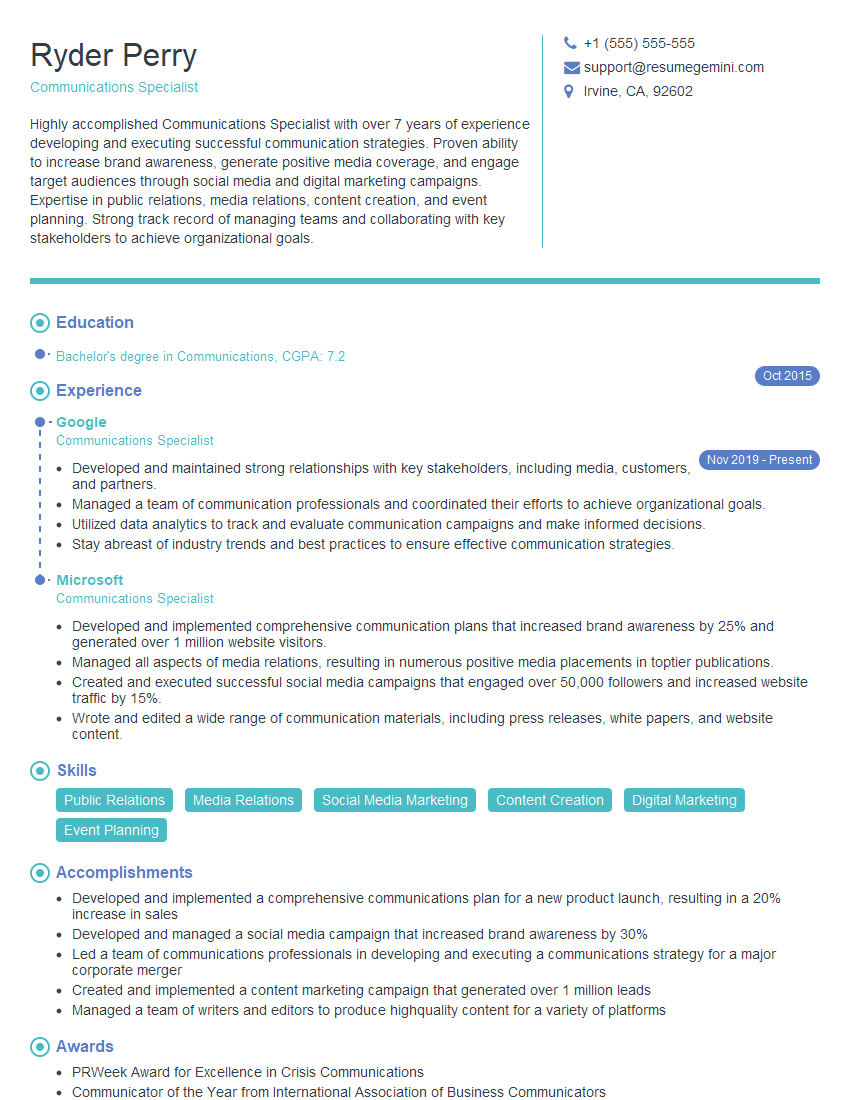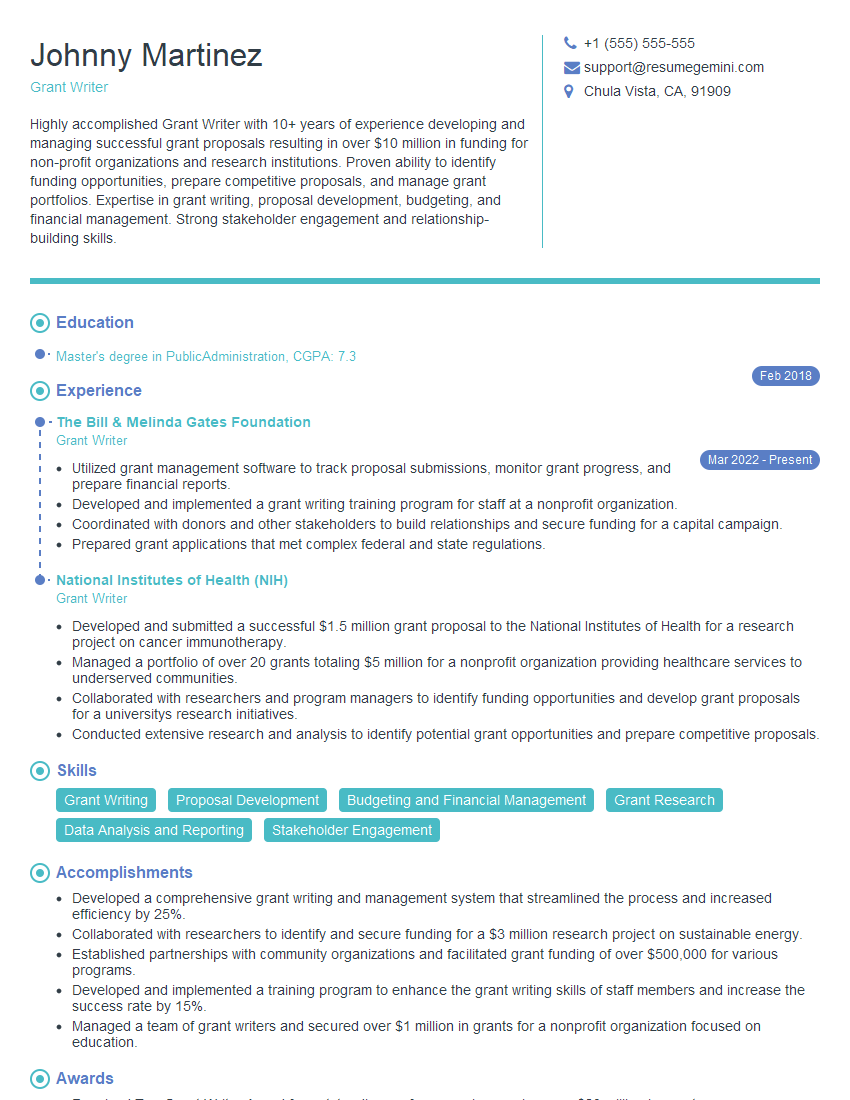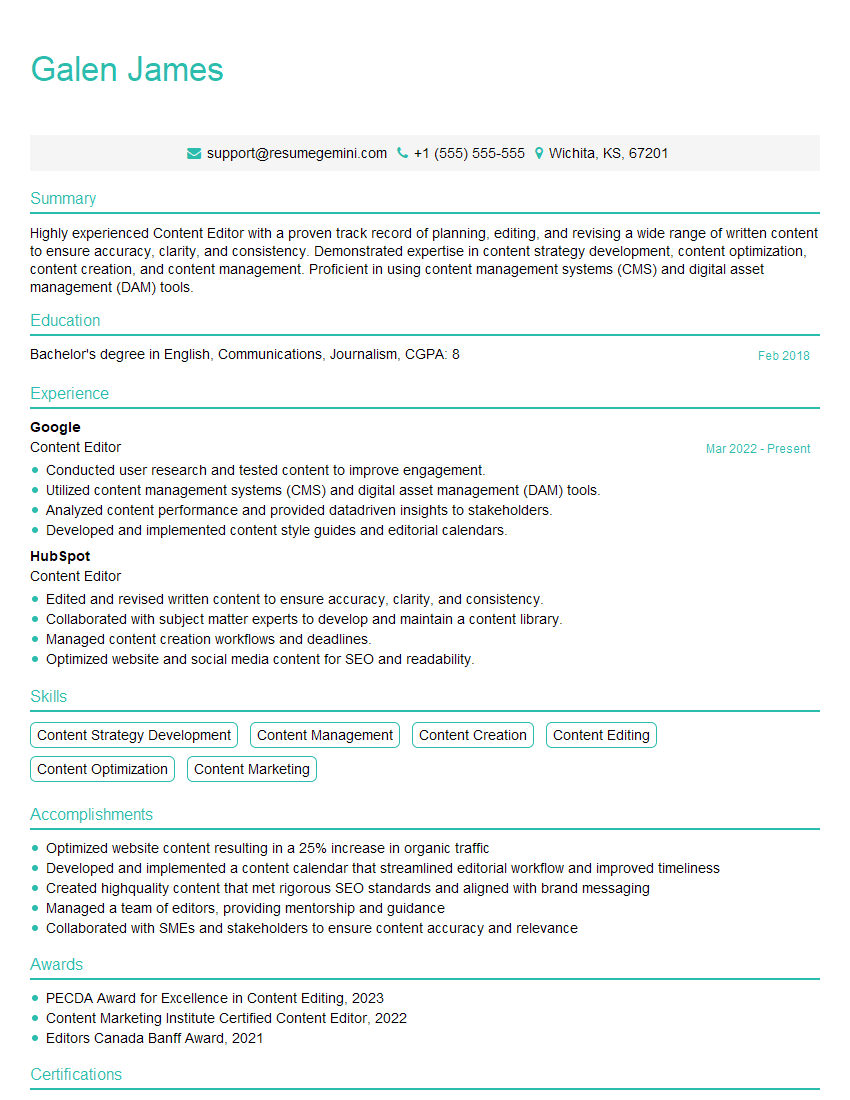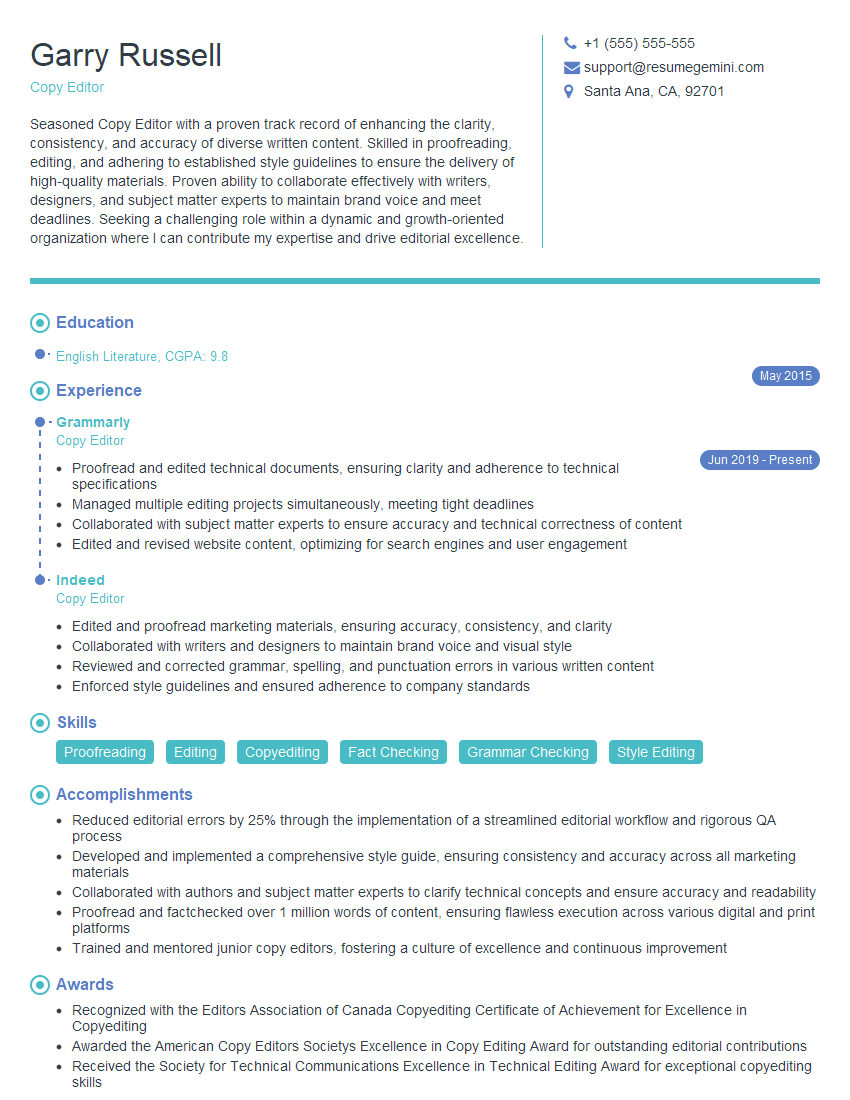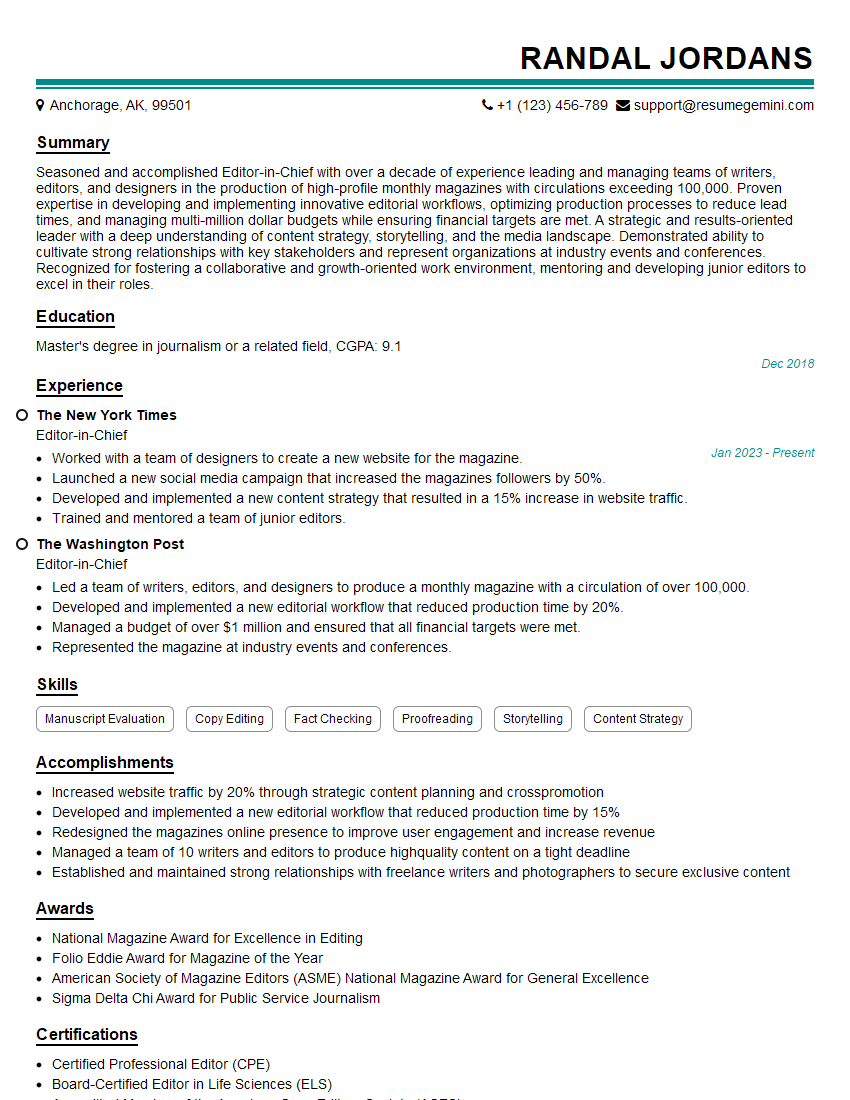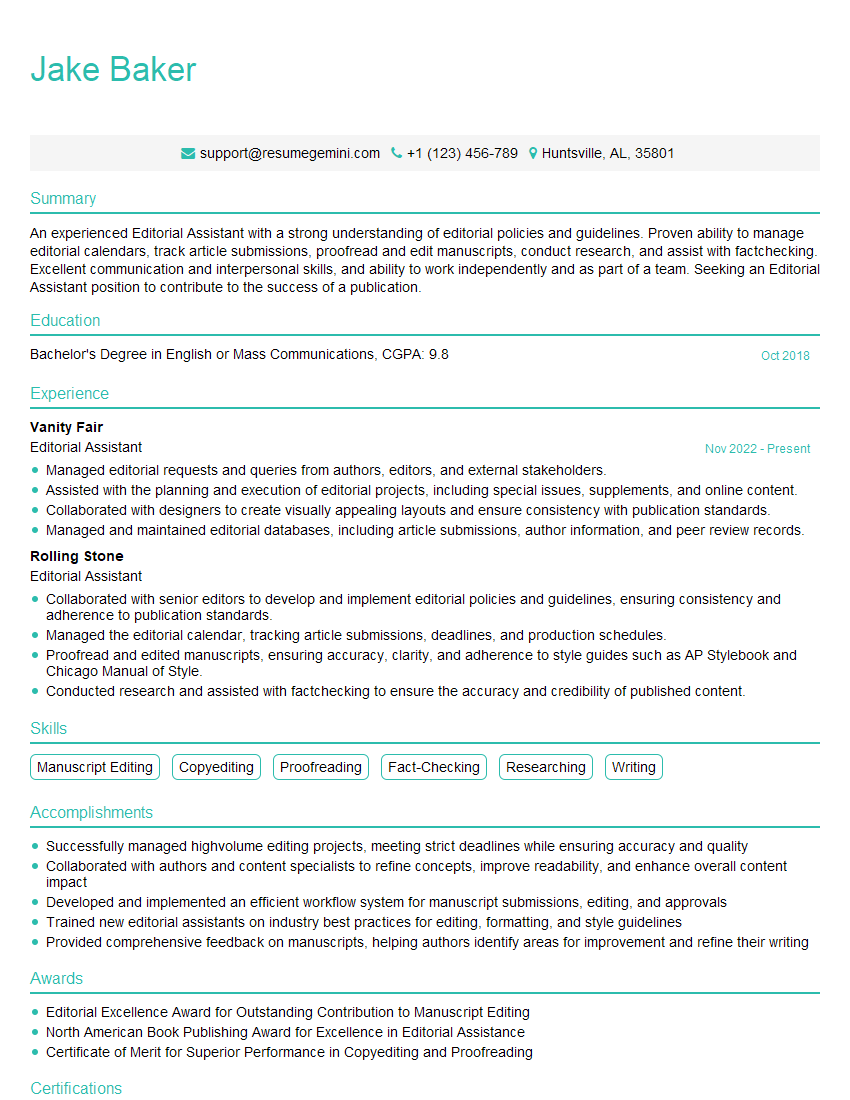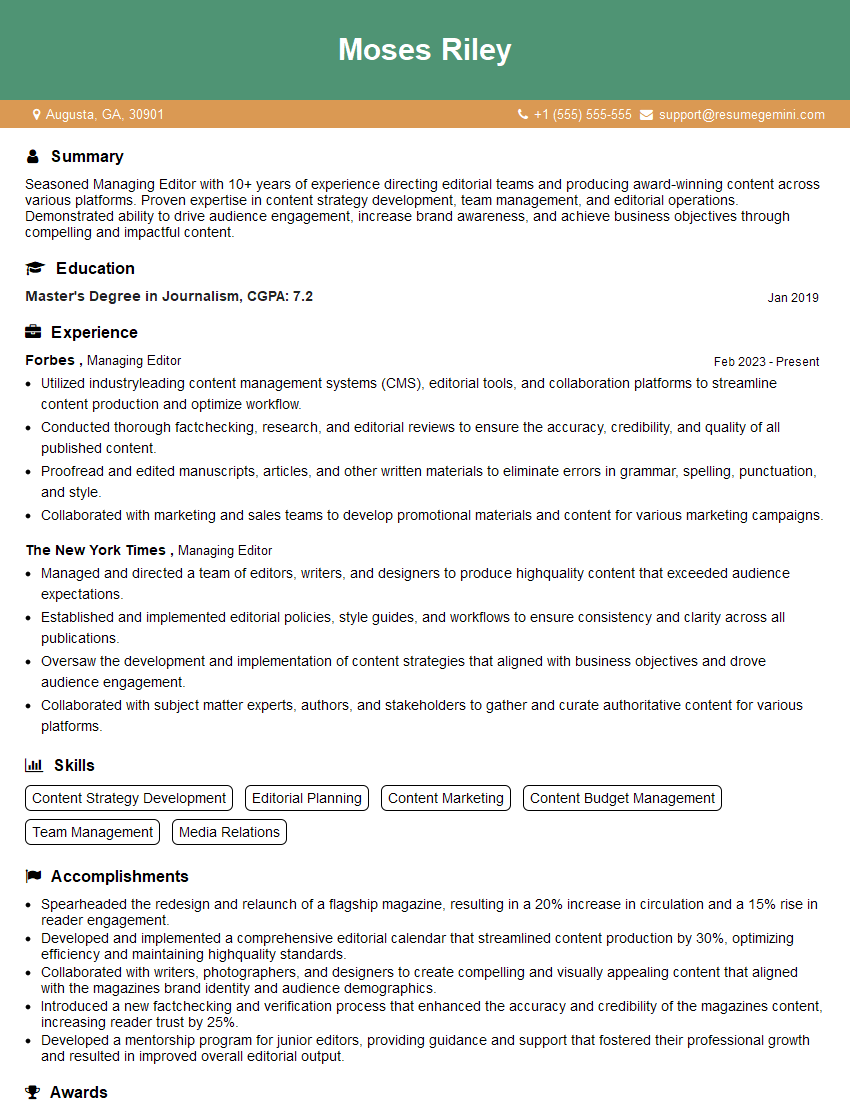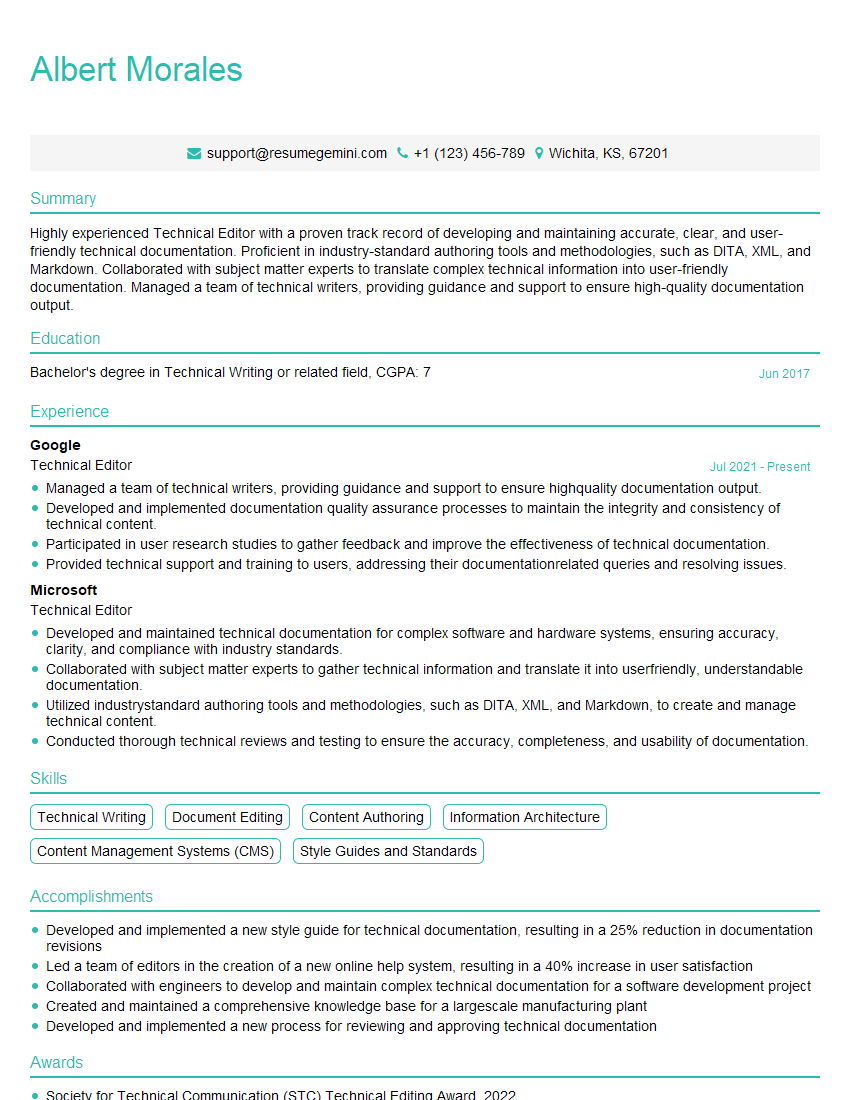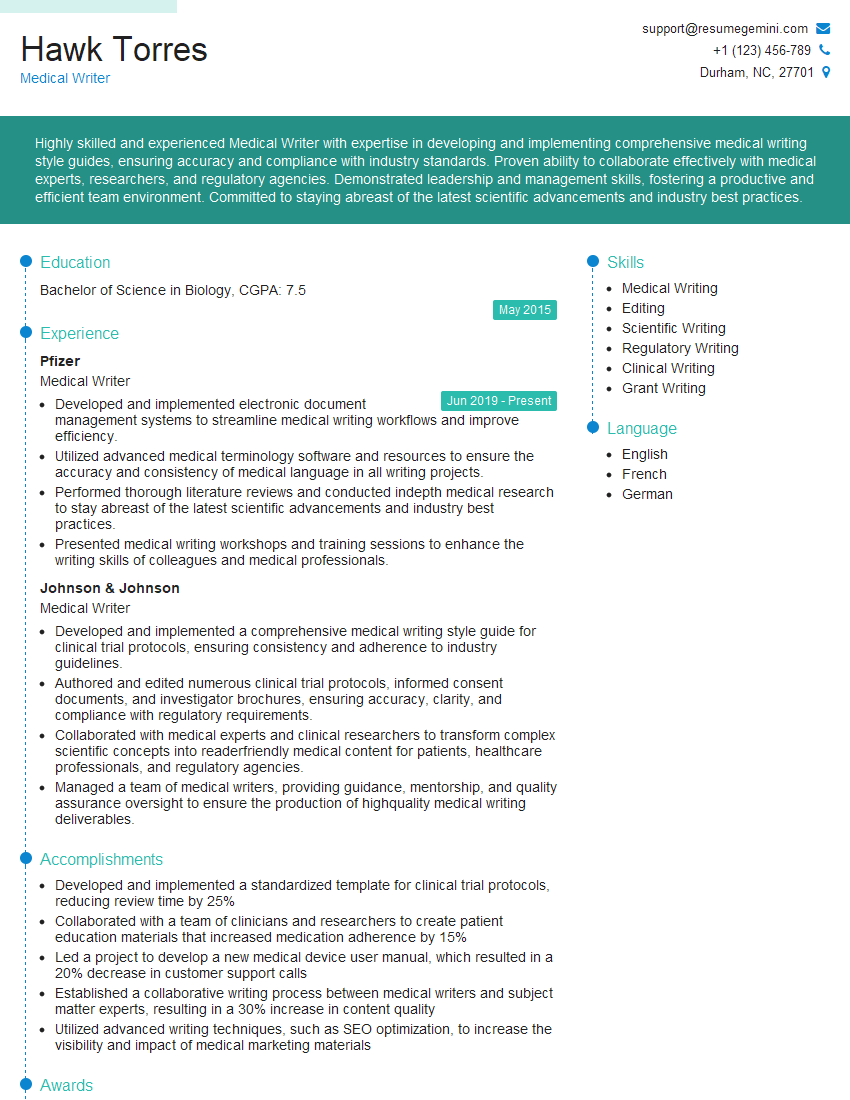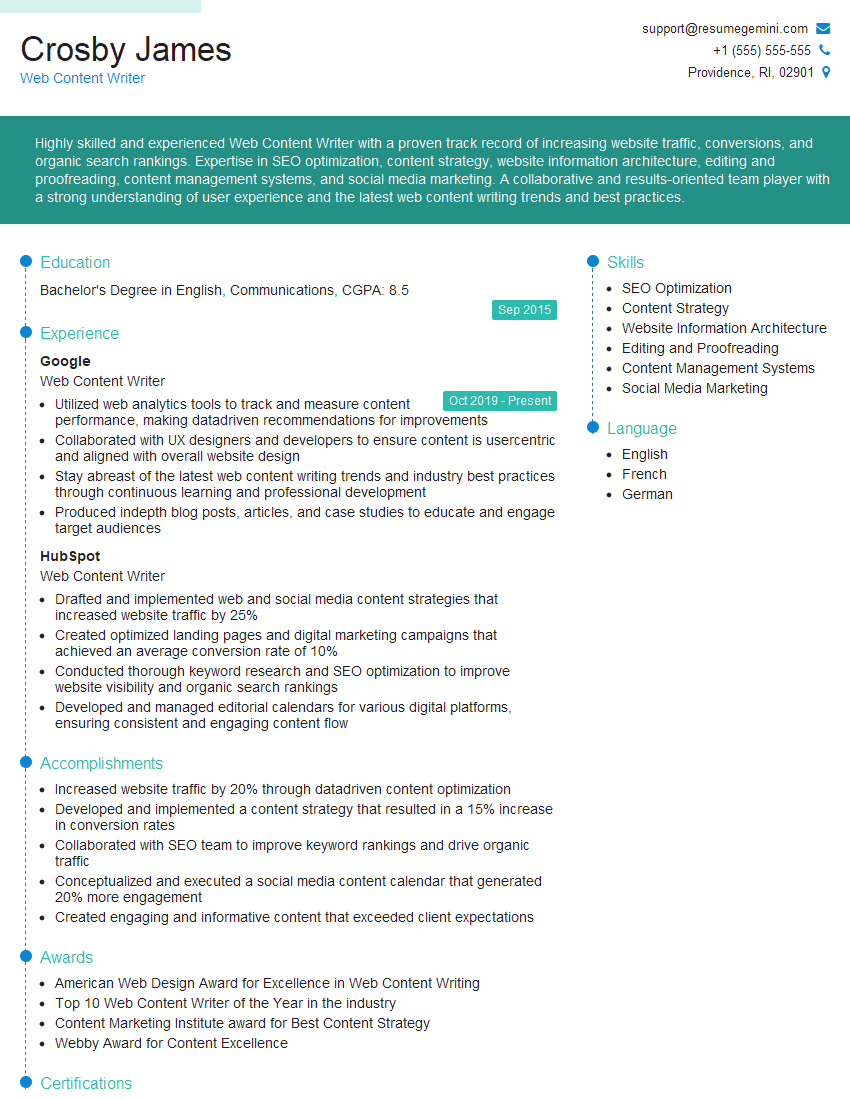The right preparation can turn an interview into an opportunity to showcase your expertise. This guide to Collaborative Writing and Editing interview questions is your ultimate resource, providing key insights and tips to help you ace your responses and stand out as a top candidate.
Questions Asked in Collaborative Writing and Editing Interview
Q 1. Describe your experience with different collaborative writing tools (e.g., Google Docs, Microsoft Word, collaborative platforms).
My experience with collaborative writing tools is extensive, spanning various platforms and functionalities. I’ve worked extensively with Google Docs, leveraging its real-time co-editing capabilities, commenting features, and version history. This is particularly useful for projects with geographically dispersed teams, allowing for seamless simultaneous editing. I’m also proficient in Microsoft Word’s co-authoring features, which offer similar benefits but with a more familiar interface for some users. Beyond these common tools, I have experience with collaborative platforms like Overleaf (for LaTeX documents), and specialized project management tools that integrate writing functionalities, enabling smoother workflow management. Each tool presents different strengths; Google Docs excels in speed and accessibility, while Microsoft Word offers more advanced formatting options. The choice depends heavily on the project’s specific needs and the team’s familiarity with the tool.
- Google Docs: Ideal for fast-paced projects and remote teams, offering real-time co-editing and robust version history.
- Microsoft Word Online: Provides a familiar interface with solid co-authoring capabilities, suitable for teams comfortable with the Microsoft ecosystem.
- Overleaf: Specialized for LaTeX documents, offering version control and collaborative features specifically tailored for scientific writing.
Q 2. Explain your approach to resolving conflicts in collaborative writing projects.
Resolving conflicts in collaborative writing is a crucial aspect of the process, requiring diplomacy and a clear understanding of the project goals. My approach begins with establishing clear communication channels. I encourage open dialogue and proactive conflict identification. When discrepancies arise, I facilitate a discussion focusing on the rationale behind different choices. We examine the merits of each proposed solution, often leveraging the ‘why’ behind each suggestion. If consensus can’t be reached through discussion, I may propose a compromise or suggest a final decision based on project needs and pre-defined editorial guidelines. Prioritizing clarity, consistency, and the overall coherence of the document guides my decision-making. For instance, if two authors offer drastically different interpretations of a key concept, I’d mediate the discussion, ensure both perspectives are understood, and then work towards a cohesive and unambiguous explanation that reflects the project’s aims.
Q 3. How do you ensure consistency in style and tone across a collaboratively written document?
Maintaining style and tone consistency in collaborative writing requires a proactive approach beginning before the writing process even starts. I advocate for the creation of a style guide at the outset, outlining preferred formatting, tone, terminology, and citation style. This serves as a common reference point for all authors. During the writing phase, we use the style guide and the collaborative platform’s commenting features to address inconsistencies immediately. For instance, if one author consistently uses active voice while another defaults to passive voice, we address this early on. Tools like Grammarly and ProWritingAid can also assist in identifying inconsistencies and enforcing style preferences across the document. Regular reviews by a designated editor or style checker further contribute to consistency.
Q 4. Describe your experience with version control in collaborative writing projects.
Version control is paramount in collaborative writing. All the tools I mentioned (Google Docs, Microsoft Word Online, Overleaf) inherently provide version history features. This allows us to track changes, revert to earlier versions if needed, and see who made what edits and when. I often use these version histories not only to address errors but also to understand the evolution of the document’s arguments and narrative. For instance, if a particular section underwent significant revisions, I can review the version history to trace the changes and understand the reasoning behind them. This provides a valuable audit trail and helps ensure that revisions are both coherent and effective.
Q 5. How do you handle feedback from multiple reviewers on a collaborative project?
Handling feedback from multiple reviewers necessitates a systematic approach. I typically create a central document (often a spreadsheet or a shared document) where feedback is organized systematically, separating suggestions by reviewer. This prevents the feedback from becoming overwhelming and disorganized. I then review all feedback, categorizing suggestions into areas like content, style, organization, and factual accuracy. I respond to each comment individually, explaining the rationale for accepting or rejecting each suggestion. This clear communication process demonstrates respect for all feedback and maintains transparency. When conflicting feedback exists, I mediate and find a solution that best serves the document’s overall quality and integrity.
Q 6. What strategies do you use to manage deadlines and workflows in collaborative writing environments?
Effective deadline and workflow management in collaborative writing hinges on clear planning and communication. At the project’s outset, I work with the team to establish a detailed timeline, outlining milestones, individual responsibilities, and deadlines. We utilize project management tools (like Trello or Asana) to track progress and ensure accountability. Regular check-in meetings provide opportunities to address challenges, adjust the schedule if necessary, and maintain open communication. A well-defined workflow – encompassing outlining, drafting, editing, and review stages – helps structure the project and ensures efficient task allocation. Breaking down large tasks into smaller, manageable components improves productivity and reduces stress. For example, a complex research paper might have separate deadlines for literature review, first draft, peer review, and final submission.
Q 7. How do you ensure the clarity and accuracy of information in collaboratively written documents?
Ensuring clarity and accuracy in collaboratively written documents demands rigorous fact-checking and editing. I always emphasize the importance of using reliable sources and documenting them properly. We implement a system of peer review where each section is critically evaluated for accuracy, clarity, and consistency. The style guide (mentioned earlier) helps ensure uniformity and prevents ambiguity. I often utilize fact-checking tools and resources to verify information presented in the document, ensuring its reliability. For example, during a collaborative project on historical events, we’d cross-reference information from multiple reputable sources to ensure accuracy and avoid potential biases. A final, thorough editorial review by an experienced editor ensures the document meets the highest standards for clarity, accuracy, and consistency before publication or submission.
Q 8. Explain your process for editing and proofreading collaboratively written content.
My collaborative editing process begins with a clear understanding of the project’s goals and target audience. I advocate for a structured approach, often using a combination of version control systems and collaborative writing platforms. Firstly, I ensure we establish a style guide early on – this could be an existing style guide or one we collaboratively create. This prevents inconsistencies from the outset. Then, I usually initiate a first round of individual editing focusing on clarity, consistency, and flow. After this individual review, we move to a collaborative phase using tools like Google Docs’ commenting feature or dedicated platforms like Microsoft SharePoint. This collaborative review allows for real-time feedback and discussion of revisions. I guide this discussion, ensuring respectful communication and a focus on improving the content, not criticizing individuals. Finally, a final proofread is conducted, checking for grammar, spelling, punctuation, and overall consistency against the agreed-upon style guide. This often involves a fresh pair of eyes – even if it’s just me taking a break and returning to the text later.
For larger projects, I might break down the editing into smaller, manageable sections, assigning specific sections to different team members for review and then integrating their edits in a structured manner. This approach promotes efficiency and reduces the likelihood of conflicts.
Q 9. Describe your experience with different editing styles (e.g., AP, Chicago, MLA).
My experience encompasses various citation and style guides, including AP, Chicago, and MLA. Each style guide has its nuances, and I am proficient in adapting my editing to meet the specific requirements of each. For instance, the AP style guide prioritizes brevity and clarity, focusing on journalistic writing, whereas Chicago is more comprehensive and often utilized in academic publications. MLA, on the other hand, is commonly used in humanities fields and emphasizes author-page citations. I understand the differences in formatting requirements for in-text citations, bibliographies, headings, and the overall tone expected in each style. I’ve worked on projects requiring adherence to all three, demonstrating my ability to switch between styles with precision and consistency.
I often begin by consulting the relevant style manual to familiarize myself with the latest updates and specific requirements. I’m a firm believer in using style guides as a living document – I regularly check for updated versions to ensure our work is always accurate and current.
Q 10. How do you incorporate feedback from different stakeholders into your editing process?
Incorporating feedback from multiple stakeholders requires a systematic approach. I begin by creating a centralized platform, such as a shared document or project management tool, where all feedback can be collected and organized. I make sure everyone knows how to provide feedback constructively, emphasizing clear explanations and suggestions for improvement rather than subjective opinions. I then review all feedback, categorizing it by type and source. This allows me to prioritize revisions based on their impact and relevance. I’ll synthesize the feedback, acknowledging all valid points and explaining any decisions made regarding conflicting suggestions. This might involve prioritizing feedback from subject matter experts or ensuring the overall message remains consistent with the project’s goals.
For example, if one stakeholder requests a more technical tone while another suggests a more approachable style, I would carefully evaluate both preferences and decide on an approach that balances both viewpoints. Transparency in this process is key to maintaining positive relationships with all stakeholders.
Q 11. What is your preferred method for tracking changes and revisions in collaborative editing projects?
My preferred method for tracking changes and revisions is using version control systems like Git, especially for larger projects, combined with the commenting features within collaborative writing software like Google Docs or Microsoft Word. Git provides a detailed history of all changes, allowing us to revert to previous versions if necessary. The commenting feature allows for real-time discussion and makes the rationale behind revisions transparent. I find this combination allows us to track changes effectively while fostering open communication among collaborators.
For smaller projects where the use of Git might seem excessive, detailed commenting and change tracking within a document itself can be equally effective. Clear and concise comments are essential, specifying the reason behind each change.
Q 12. How do you maintain a positive and productive working relationship with collaborators?
Maintaining positive and productive relationships relies on open communication, respect, and clear expectations. I ensure everyone understands their roles and responsibilities from the outset. Regular check-ins, whether through brief meetings or email updates, help keep everyone informed and engaged. Active listening and a willingness to consider different perspectives are crucial. I aim to create a collaborative environment where all contributors feel valued and respected, fostering a sense of shared ownership and responsibility for the final product. Acknowledging individual contributions and celebrating milestones along the way also helps boost morale and strengthen teamwork.
Conflict resolution is a key aspect of this. I always aim to address disagreements constructively, focusing on the task at hand rather than personalities. I often encourage brainstorming sessions or using a structured approach to decision-making to ensure everyone feels heard.
Q 13. Describe a time you had to mediate a disagreement between collaborators on a writing project.
In one project, we had a major disagreement about the tone of the introduction. One collaborator favored a more formal, academic tone, while another preferred a more informal, engaging style. This led to a standstill in progress. To mediate, I initiated a discussion, first ensuring everyone felt safe to express their opinions. I then guided them through exploring the rationale behind their preferences. We reviewed the target audience and the project’s goals, reminding everyone that the tone should serve those objectives. After a careful consideration of these factors, we decided on a compromise – a slightly more formal introduction but with elements of engaging storytelling. The solution wasn’t solely what one side preferred; it was a synthesis of ideas that incorporated valuable input from both. The crucial element was to focus on finding a solution that met the project’s needs while valuing each collaborator’s input.
Q 14. How do you adapt your writing and editing style to suit different audiences and purposes?
Adapting my writing and editing style involves a deep understanding of the intended audience and the purpose of the content. For example, writing a technical manual requires precise language, clear instructions, and avoidance of ambiguity. In contrast, writing a marketing brochure needs a persuasive tone, strong calls to action, and attention-grabbing language. Understanding the audience’s background, knowledge level, and expectations is paramount. I often consider the reader’s needs and tailor my language, tone, and structure accordingly. I might adopt a more formal tone for academic publications but use simpler language for general audiences. This adaptability ensures the content resonates effectively with its intended readership and achieves its purpose.
I use a range of techniques, such as simplifying complex jargon, using varied sentence structures, incorporating visuals to improve understanding, and ensuring the overall readability and engagement level aligns with the audience and objective.
Q 15. Describe your experience with working on projects that require subject-matter expertise.
My experience with projects requiring subject-matter expertise is extensive. I’ve worked on numerous collaborative writing projects spanning diverse fields, from medical research papers requiring in-depth knowledge of clinical trials and statistical analysis to marketing campaigns demanding a solid understanding of target audiences and consumer behavior. In each case, I began by immersing myself in the subject matter. This often involved reviewing existing literature, consulting with experts, and conducting thorough research. For instance, on a project involving a white paper on a new pharmaceutical drug, I spent several weeks studying clinical trial data, publications, and regulatory guidelines before even beginning the writing process. This foundational understanding allows me to not only contribute to the writing but also to critically evaluate the work of others, ensuring accuracy and consistency throughout the collaborative process.
For example, in a project about sustainable agriculture, my prior knowledge of soil science allowed me to identify and correct inaccuracies related to nutrient cycling and water management in a colleague’s draft. I collaborated with the author, explaining my corrections with the support of peer-reviewed research and other relevant data. This ensured the final product was both accurate and credible. I view my subject matter expertise as a cornerstone of successful collaborative projects—it’s the foundation upon which trust and effective collaboration are built.
Career Expert Tips:
- Ace those interviews! Prepare effectively by reviewing the Top 50 Most Common Interview Questions on ResumeGemini.
- Navigate your job search with confidence! Explore a wide range of Career Tips on ResumeGemini. Learn about common challenges and recommendations to overcome them.
- Craft the perfect resume! Master the Art of Resume Writing with ResumeGemini’s guide. Showcase your unique qualifications and achievements effectively.
- Don’t miss out on holiday savings! Build your dream resume with ResumeGemini’s ATS optimized templates.
Q 16. How do you ensure the accessibility and inclusivity of collaboratively written content?
Ensuring accessibility and inclusivity in collaboratively written content is paramount. It’s about creating content that is understandable and usable by everyone, regardless of their abilities or backgrounds. This starts with using clear and concise language, avoiding jargon and overly complex sentence structures. We aim for plain language principles to ensure broad comprehension. We utilize tools like readability checkers to measure the complexity of the text and identify areas for improvement.
Furthermore, we actively consider the needs of people with disabilities. This includes providing alternative text for images (alt text), ensuring sufficient color contrast for readability, and structuring documents with clear headings and subheadings to facilitate navigation for screen reader users. We also incorporate diverse perspectives and voices throughout the writing and editing process. This might involve including contributions from individuals with different backgrounds and experiences or actively seeking feedback from diverse groups. Finally, we prioritize inclusive language, carefully avoiding stereotypes and biased language that might marginalize certain groups.
Q 17. What strategies do you use to improve the readability and engagement of collaboratively written documents?
Improving the readability and engagement of collaboratively written documents involves a multi-faceted approach. First, we focus on clear and concise writing—getting straight to the point and avoiding unnecessary jargon. We strive for a consistent tone and style throughout the document, which enhances readability and improves the overall experience for the reader. Think of it like building a house—a consistent style makes it look cohesive and appealing, while inconsistent styles make it seem disjointed and unprofessional.
To boost engagement, we incorporate various techniques. This includes using storytelling techniques, incorporating visuals like charts and graphs, and breaking up large chunks of text with headings, subheadings, bullet points, and white space. We also aim for active voice whenever possible, as it generally makes writing more direct and engaging. Engaging the reader’s emotions, when appropriate, and using strong verbs can significantly boost engagement. Finally, throughout the collaborative process, we regularly review the document for clarity and engagement, seeking feedback from multiple team members and considering diverse perspectives. This feedback loop is crucial to optimizing the document’s impact.
Q 18. How do you identify and correct grammatical errors, stylistic inconsistencies, and factual inaccuracies?
Identifying and correcting errors is a systematic process. We begin by using grammar and spell checkers, but understand that these are tools, not replacements for careful human review. These tools help to identify basic errors, but they often miss subtle grammatical nuances or stylistic inconsistencies. A thorough review is always needed. For stylistic inconsistencies, we typically adhere to a chosen style guide (like the Chicago Manual of Style or AP Stylebook), which provides a framework for consistency in formatting, punctuation, and style choices.
Fact-checking is crucial. We use multiple sources to verify information and cross-reference data. Any discrepancy is thoroughly investigated to ensure accuracy. For example, when writing about historical events, we consult multiple reliable primary and secondary sources to verify details. We track our sources meticulously to ensure transparency and credibility. The final step involves multiple rounds of proofreading to catch any remaining errors. This process is done by multiple individuals—fresh eyes often spot mistakes that others have overlooked. This layered approach reduces errors and ensures quality control.
Q 19. What are some common challenges you encounter in collaborative writing and editing projects, and how do you overcome them?
Collaborative writing and editing projects face unique challenges. One common issue is managing differing writing styles and preferences among collaborators. We overcome this by establishing a clear style guide early on and having regular communication to ensure everyone is on the same page. Another challenge is coordinating schedules and workloads, especially when team members are geographically dispersed or have conflicting deadlines. We use project management tools and regular team meetings to stay organized and on track. Clear task assignments and consistent communication are key.
Version control can also be tricky. We use collaborative writing platforms that track changes and allow for easy comparison of different versions. This ensures that everyone is working from the most up-to-date version and that all changes are documented. Finally, conflict resolution is sometimes necessary. We address disagreements constructively and focus on finding solutions that work for everyone. This might involve mediation, compromise, or appealing to established style guides or expert opinions. Open communication and a collaborative spirit are essential to navigate these challenges effectively.
Q 20. Describe your experience with using style guides and editorial guidelines.
My experience with style guides and editorial guidelines is extensive. I’m proficient in several widely used style guides, including the Chicago Manual of Style, the Associated Press Stylebook, and the MLA Handbook. I understand that consistency is paramount in professional writing and editing, and style guides provide the necessary framework for achieving this. I’ve used these guides in countless projects, ensuring uniformity in punctuation, capitalization, citation, and other stylistic elements.
For example, in a scientific publication, adhering to a specific style guide (like AMA) is essential for the paper’s acceptance. The guide dictates how references are formatted, the style for numbers and units, and the overall presentation of the manuscript. My familiarity with these guidelines helps speed up the process and improves the overall quality of the final product, ensuring clarity and credibility for the publication. The use of style guides ensures consistency and professionalism, giving a sense of authority and trust to the reader.
Q 21. How do you prioritize tasks and manage your time effectively in a collaborative writing and editing environment?
Prioritizing tasks and managing time effectively in a collaborative environment involves a combination of strategies. I begin by clearly defining project goals and breaking them down into smaller, manageable tasks. Then, I create a project schedule or timeline that outlines key deadlines and milestones. This allows me and the team to clearly see what needs to be done and when. I leverage project management tools to track progress and manage tasks, often assigning tasks to individual team members based on their strengths and availability.
Regular communication is key. I schedule regular team meetings (in-person or virtual) to discuss progress, address challenges, and ensure everyone is on the same page. Effective time management also involves prioritizing tasks, focusing on the most important and urgent items first, and delegating tasks whenever possible. I always build buffer time into the schedule to account for unexpected delays or unforeseen challenges. This proactive approach helps mitigate potential setbacks and keep the project moving forward smoothly. Knowing when to delegate tasks to improve overall workflow is a crucial skill.
Q 22. How do you ensure that the final product meets the client’s expectations and specifications?
Meeting client expectations is paramount in collaborative writing. It’s a multi-stage process beginning with meticulous project scoping. We establish clear communication channels and utilize detailed project briefs outlining specific requirements, target audience, desired tone, style guide adherence, and deliverable formats. Regular check-ins, feedback loops, and iterative reviews throughout the writing and editing process are crucial. We use version control systems to track changes and ensure everyone is aligned. For instance, if a client requires a specific SEO keyword density, we integrate that into the brief and monitor its inclusion during the writing phase. Ultimately, a final review session with the client allows for any necessary adjustments before the final product is delivered. Think of it like building a house: the project brief is the blueprint, the check-ins are site visits, and the final review is the final inspection.
Q 23. Explain your understanding of copyright and plagiarism in the context of collaborative writing.
Copyright and plagiarism are critical concerns in collaborative writing. Copyright protects the original expression of ideas, not the ideas themselves. In collaborative projects, each contributor generally holds copyright to their specific contributions unless otherwise agreed upon in a contract. Plagiarism, on the other hand, is the act of presenting someone else’s work or ideas as your own. To avoid this, we establish clear guidelines about sourcing and referencing, promoting transparency and accountability amongst collaborators. Each contributor is responsible for ensuring all materials used are appropriately cited and permission is obtained for any copyrighted work. We often use plagiarism detection software during the editing phase to ensure originality and adherence to ethical writing practices. Think of it like baking a cake—each person contributes their specific ingredient, but everyone is responsible for ensuring the recipe is followed and that no one steals the recipe from another baker.
Q 24. How do you handle situations where collaborators miss deadlines or fail to fulfill their responsibilities?
Missed deadlines and unfulfilled responsibilities can derail a project. Proactive communication is key. We establish clear roles and responsibilities from the outset, along with realistic deadlines. Regular progress updates and check-ins allow us to identify potential issues early. If a collaborator falls behind, we investigate the reasons, offering support where possible. This might involve re-allocating tasks, adjusting deadlines, or providing additional training. In serious cases of consistent non-performance, we may have to replace the individual to safeguard project timelines and quality. A structured approach, using project management tools with clear task assignments and dependencies, minimizes the risk of these problems.
Q 25. What measures do you take to ensure the confidentiality and security of collaboratively written documents?
Confidentiality and security are crucial, especially with sensitive information. We use secure platforms for communication and document storage, such as encrypted cloud services and password-protected shared drives. Access control measures restrict document viewing only to authorized personnel. Non-disclosure agreements (NDAs) are often employed for projects involving confidential information. Furthermore, we train collaborators on data security best practices. For example, we might use a cloud storage system with role-based access control, ensuring only editors can modify documents and reviewers only have read-only access. This layered approach protects the project’s integrity and sensitive information from unauthorized access.
Q 26. How do you use technology to enhance collaboration and efficiency in writing and editing?
Technology significantly boosts collaborative writing efficiency. We use a range of tools, including Google Docs for real-time co-authoring and editing, Slack for communication, Asana or Trello for task management, and Grammarly for grammar and style checks. Version control systems like Git allow us to track changes, revert to previous versions, and merge contributions seamlessly. For example, using Google Docs’ comment feature facilitates efficient feedback exchange. Such tools streamline workflows, improve communication, and enhance the overall quality of the final product, making the process more collaborative and less prone to errors.
Q 27. Describe your experience with working on large-scale collaborative writing projects.
I’ve been involved in several large-scale projects, including the creation of a comprehensive online encyclopedia and a multi-author textbook. In these projects, a clear project structure with well-defined roles was essential. We divided the project into manageable modules, assigning different teams to each. Regular project meetings and detailed progress reports kept everyone informed and aligned. The use of a central repository for all documents, utilizing a version control system, helped prevent version conflicts and ensured seamless integration of individual contributions. The key to success was open communication, well-defined processes, and the right tools, mirroring the efficiency of a well-organized orchestra.
Q 28. How do you stay up-to-date on the latest trends and best practices in collaborative writing and editing?
Staying current is crucial in this dynamic field. I regularly attend industry conferences and webinars, subscribe to relevant journals and newsletters, and actively participate in online communities related to collaborative writing. Following thought leaders on social media, exploring new collaboration tools, and reviewing best practice guides keep me abreast of evolving techniques and technologies. Continuing professional development courses and workshops ensure I’m constantly expanding my skillset and adapting to the latest trends in collaborative writing and editing.
Key Topics to Learn for Collaborative Writing and Editing Interview
- Version Control Systems (VCS): Understanding Git, GitHub, or similar platforms is crucial for managing collaborative projects. Learn about branching, merging, and resolving conflicts.
- Collaborative Platforms & Tools: Gain familiarity with platforms like Google Docs, Microsoft Office 365, or specialized writing/editing software. Understand their collaborative features and limitations.
- Style Guides and Consistency: Demonstrate your understanding of applying style guides (e.g., Chicago Manual of Style, AP Stylebook) and maintaining consistency across a document collaboratively authored.
- Communication & Feedback Strategies: Master effective communication techniques for providing and receiving constructive criticism in a collaborative environment. Practice active listening and respectful disagreement.
- Workflow & Project Management: Learn different collaborative writing workflows (e.g., iterative, parallel) and how to manage tasks and deadlines effectively in a team setting.
- Conflict Resolution & Negotiation: Explore strategies for resolving disagreements about content, style, or direction. Practice effective negotiation and compromise skills.
- Attribution & Authorship: Understand ethical considerations around authorship, plagiarism, and proper attribution in collaborative projects.
- Accessibility & Inclusivity: Demonstrate awareness of writing and editing for accessibility and inclusivity, considering diverse audiences and perspectives.
Next Steps
Mastering collaborative writing and editing is increasingly vital for success in many fields, opening doors to exciting opportunities and higher earning potential. A strong resume is your first impression – making it ATS-friendly is crucial for getting noticed by potential employers. To significantly enhance your job prospects, leverage the power of ResumeGemini to build a professional and effective resume that showcases your skills in collaborative writing and editing. ResumeGemini provides examples of resumes tailored specifically to this field, giving you a head start in crafting a winning application.
Explore more articles
Users Rating of Our Blogs
Share Your Experience
We value your feedback! Please rate our content and share your thoughts (optional).
What Readers Say About Our Blog
Interesting Article, I liked the depth of knowledge you’ve shared.
Helpful, thanks for sharing.
Hi, I represent a social media marketing agency and liked your blog
Hi, I represent an SEO company that specialises in getting you AI citations and higher rankings on Google. I’d like to offer you a 100% free SEO audit for your website. Would you be interested?
